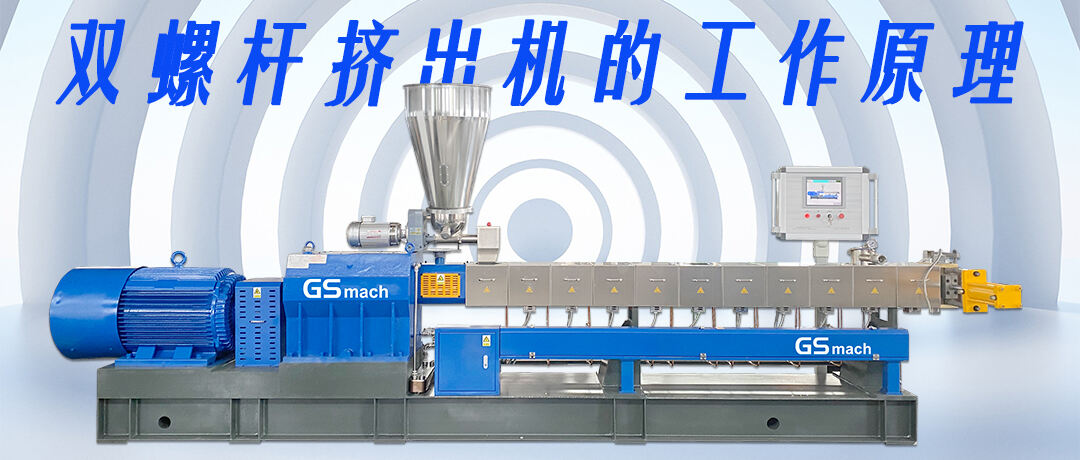트윈 스크류 압출기의 작동 원리

쌍나선 압출기와 단일 나선 압출기의 구조는 매우 유사하지만, 그 작동 원리는 다릅니다. 단일 나선 압출기에서는 물질의 이동이 물질의 마찰력과 점성 저항에 의존하므로 체류 시간 분포가 넓습니다.
대조적으로, 쌍나선 압출기는 나선의 양수송에 의존하므로 체류 시간 분포가 좁다. 쌍나선 압출기의 원료는 계량 급여기를 통해 급여구에서 공급된다. 일부 첨가제(유리 섬유 등)는 배럴 중간의 급여구를 통해 추가로 공급되어 나선에 의해 다이 헤드까지 운반된다.
이 과정에서 물질의 이동은 나선의 결합 모드와 회전 방향에 따라 달라진다. 본 논문에서는 이러한 관점에서 그 작동 원리의 구체적인 차이점을 소개할 것이다.
쌍나선 압출기는 어떻게 작동하는가?
먼저, 쌍나선 압출기가 플라스틱 분야에서의 응용을 예시로 들어 쌍나선 압출기의 작동 원리를 간략히 설명한다. 이후에는 '나선의 결합 및 회전 방향이 다르다'는 관점에서 그들의 차이점을 구체적으로 소개할 것이다.
트윈 스크류 엑스트루더
작동 방식은 다음과 같다.
1. 쌍스크류 압출기 작동 후, 플라스틱 입자나 분말이 피딩 시스템을 통해 스크류 홈에 처음으로 공급됩니다. 피딩 시스템은 일반적으로 피딩 포트, 피더, 홉퍼 및 피딩 스크류로 구성됩니다. 플라스틱 원료는 홉퍼 진동 또는 피더의 회전에 의해 피드 스크류로 균일하게 공급됩니다.
먹이는
2. 플라스틱 원료가 스크류 홈으로 들어가면 쌍 스크류가 회전을 시작합니다. 나선 홈의 간격과 깊이를 조절하여 플라스틱 원료를 전단에서 후단으로 이동시킵니다. 추진 과정 중, 플라스틱 원료는 배럴 외부와 나선 홈 사이에서 압축되어 전단력과 마찰이 발생합니다. 이로 인해 고속 마찰과 열로 인해 플라스틱 원료가 가열되고, 히팅 시스템은 추가적인 열 에너지를 제공하여 플라스틱 원료를 점진적으로 열가소성 용융물로 변화시킵니다.
스크류 회전 과정
3. 압출 과정: 용융된 플라스틱이 일정 수준에 도달하면, 부분적으로 압출기의 배럴로 들어갑니다. 이 부분은 일반적으로 확장된 나선형 홈과 압출 다이 헤드로 구성됩니다. 압출 섹션에서 나선형 홈의 간격이 점차 줄어들어 압력이 증가하고, 이는 플라스틱의 용해를 더욱 촉진합니다. 압출 금형은 특정 구조와 통로를 통해 용융된 플라스틱을 원하는 단면과 길이로 형성합니다. 압출 출구에는 보통 냉각 시스템이 장착되어 있어 용융된 플라스틱을 신속하게 냉각하고 고체화시킵니다.
진압 과정
제어 시스템은 쌍스크류 압출기의 작동에서 중요한 역할을 합니다. 제어 시스템을 통해 원료 공급, 스크류 속도, 온도 및 압력 파라미터를 실시간으로 모니터링하고 조정하여 압출 과정의 안정성과 제어 가능성을 보장할 수 있습니다. 제어 시스템은 또한 제품 요구 사항에 따라 스크류 속도, 온도 및 형상을 조정하여 이상적인 압출 효과를 달성할 수 있습니다.
쌍스크류 압출기에 대해 더 알아보려면 저희에게 연락해 주세요!


